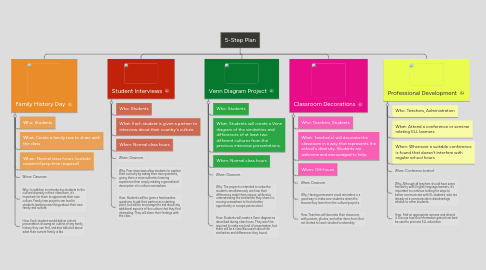5-Step Plan
저자: Erik Olson

1. Professional Development
1.1. Who: Teachers, Administration
1.2. What: Attend a conference or seminar relating ELL learners
1.3. When: Whenever a suitable conference is found that doesn't interfere with regular school hours
1.4. Where: (Conference location)
1.5. Why: Although all teachers should have some familiarity with English language learners, it's important to continue looking for ways to better communicate with EL students, who are already at a communication disadvantage relative to other students.
1.6. How: Find an appropriate seminar and attend it. Discuss how the information gained can best be used to promote ELL education.
2. Classroom Decorations
2.1. Who: Teachers, Students
2.2. What: Teacher(s) will decorate the classroom in a way that represents the school's diversity. Students are welcome and encouraged to help.
2.3. When: Off-hours
2.4. Where: Classroom
2.5. Why: Having permanent visual reminders is a good way to make sure students retain the lessons they learn from the cultural projects.
2.6. How: Teachers will decorate their classroom with posters, photos, and other items from (but not limited to) each student's nationality.
3. Venn Diagram Project
3.1. Who: Students
3.2. What: Students will create a Venn diagram of the similarities and differences of at least two different cultures from the previous interview presentations.
3.3. When: Normal class hours
3.4. Where: Classroom
3.5. Why: The project is intended to make the students simultaneously see how their differences make them unique, while also understanding the similarities they share (i.e. moving somewhere to find a better opportunity or escape persecution).
3.6. How: Students will create a Venn diagram as described during class hours. They won't be required to make any kind of presentation, but there will be a class discussion about the similarities and differences they found.
4. Student Interviews
4.1. Who: Students
4.2. What: Each student is given a partner to interview about their country's culture.
4.3. When: Normal class hours
4.4. Where: Classroom
4.5. Why: Peer interviews allow students to explore their curiosity by asking their own questions, giving them a more authentic learning experience than simply reading a generalized description of a culture somewhere.
4.6. How: Students will be given a few baseline questions to ask their partner as a starting point, but will be encouraged to ask about any additional aspects of the culture that they find interesting. They will share their findings with the class.
5. Family History Day
5.1. Who: Students
5.2. What: Create a family tree to share with the class
5.3. When: Normal class hours (outside research/prep time required)
5.4. Where: Classroom
5.5. Why: In addition to introducing students to the cultural diversity in their classroom, it's important for them to appreciate their own culture. Family tree projects can lead to students learning new things about their own family and culture.
5.6. How: Each student would deliver a short presentation showing an outline of any family history they can find, and also talk a bit about what their current family is like.


